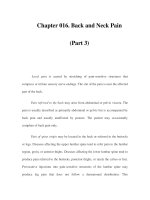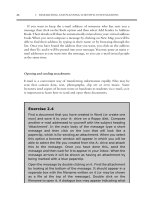Composites Manufacturing - Materials, Product, and Process Engineering Part 3 pps
Bạn đang xem bản rút gọn của tài liệu. Xem và tải ngay bản đầy đủ của tài liệu tại đây (65.07 KB, 3 trang )
© 2002 by CRC Press LLC
which isocyanate and polyol are generally mixed in a ratio of 1:1 in a reaction
chamber and then rapidly injected into a closed mold containing short or
long fiber reinforcements. RRIM and SRIM processes are low-cost and high-
volume production methods. The automotive industry is a big market for
these processes. Polyurethane is currently used for automotive applications
such as bumper beams, hoods, body panels, etc. Unfilled polyurethane is
used for various applications, including truck wheels, seat and furniture
cushions, mattress foam, etc. Polyurethane is also used for wear and impact
resistance coatings.
Polyurethane can be a thermosetting or thermoplastic resin, depending on
the functionality of the selected polyols. Thermoplastic-based polyurethane
contains linear molecules, whereas thermoset-based resin contains cross-
linked molecules.
Polyurethane is obtained by the reaction between polyisocyanate and a
polyhydroxyl group. There are a variety of polyurethanes available by select-
ing various types of polyisocyanate and polyhydroxyl ingredients. Polyure-
thane offers excellent wear, tear, and chemical resistance, good toughness,
and high resilience.
2.3.2 Thermoplastic Resins
Thermoplastic materials are, in general, ductile and tougher than thermoset
materials and are used for a wide variety of nonstructural applications with-
out fillers and reinforcements. Thermoplastics can be melted by heating and
solidified by cooling, which render them capable of repeated reshaping and
reforming. Thermoplastic molecules do not cross-link and therefore they are
flexible and reformable. Thermoplastics can be either amorphous or semi-
crystalline, as shown in Figure 2.5. In amorphous thermoplastics, molecules
are randomly arranged; whereas in the crystalline region of semi-crystalline
plastics, molecules are arranged in an orderly fashion. It is not possible to
have 100% crystallinity in plastics because of the complex nature of the
molecules. Some of the properties of themoplastics are given in Table 2.3.
Their lower stiffness and strength values require the use of fillers and rein-
forcements for structural applications. Thermoplastics generally exhibit poor
creep resistance, especially at elevated temperatures, as compared to thermo-
sets. They are more susceptible to solvents than thermosets. Thermoplastic
resins can be welded together, making repair and joining of parts more simple
than for thermosets. Repair of thermoset composites is a complicated process,
requiring adhesives and careful surface preparation. Thermoplastic compos-
ites typically require higher forming temperatures and pressures than com-
parable thermoset systems. Thermoplastic composites do not enjoy as high
a level of integration as is currently obtained with thermosetting systems.
The higher viscosity of thermoplastic resins makes some manufacturing pro-
cesses, such as hand lay-up and tape winding operations, more difficult. As
a consequence of this, the fabrication of thermoplastic composite parts have
drawn a lot of attention from researchers to overcome these problems.
© 2002 by CRC Press LLC
which isocyanate and polyol are generally mixed in a ratio of 1:1 in a reaction
chamber and then rapidly injected into a closed mold containing short or
long fiber reinforcements. RRIM and SRIM processes are low-cost and high-
volume production methods. The automotive industry is a big market for
these processes. Polyurethane is currently used for automotive applications
such as bumper beams, hoods, body panels, etc. Unfilled polyurethane is
used for various applications, including truck wheels, seat and furniture
cushions, mattress foam, etc. Polyurethane is also used for wear and impact
resistance coatings.
Polyurethane can be a thermosetting or thermoplastic resin, depending on
the functionality of the selected polyols. Thermoplastic-based polyurethane
contains linear molecules, whereas thermoset-based resin contains cross-
linked molecules.
Polyurethane is obtained by the reaction between polyisocyanate and a
polyhydroxyl group. There are a variety of polyurethanes available by select-
ing various types of polyisocyanate and polyhydroxyl ingredients. Polyure-
thane offers excellent wear, tear, and chemical resistance, good toughness,
and high resilience.
2.3.2 Thermoplastic Resins
Thermoplastic materials are, in general, ductile and tougher than thermoset
materials and are used for a wide variety of nonstructural applications with-
out fillers and reinforcements. Thermoplastics can be melted by heating and
solidified by cooling, which render them capable of repeated reshaping and
reforming. Thermoplastic molecules do not cross-link and therefore they are
flexible and reformable. Thermoplastics can be either amorphous or semi-
crystalline, as shown in Figure 2.5. In amorphous thermoplastics, molecules
are randomly arranged; whereas in the crystalline region of semi-crystalline
plastics, molecules are arranged in an orderly fashion. It is not possible to
have 100% crystallinity in plastics because of the complex nature of the
molecules. Some of the properties of themoplastics are given in Table 2.3.
Their lower stiffness and strength values require the use of fillers and rein-
forcements for structural applications. Thermoplastics generally exhibit poor
creep resistance, especially at elevated temperatures, as compared to thermo-
sets. They are more susceptible to solvents than thermosets. Thermoplastic
resins can be welded together, making repair and joining of parts more simple
than for thermosets. Repair of thermoset composites is a complicated process,
requiring adhesives and careful surface preparation. Thermoplastic compos-
ites typically require higher forming temperatures and pressures than com-
parable thermoset systems. Thermoplastic composites do not enjoy as high
a level of integration as is currently obtained with thermosetting systems.
The higher viscosity of thermoplastic resins makes some manufacturing pro-
cesses, such as hand lay-up and tape winding operations, more difficult. As
a consequence of this, the fabrication of thermoplastic composite parts have
drawn a lot of attention from researchers to overcome these problems.
© 2002 by CRC Press LLC
3
Material Selection Guidelines
3.1 Introduction
The behavior and performance of a product depend on the types of materials
used in making the part. There are more than 50,000 materials available for
the design and manufacture of a product. Every material cannot be a right
choice for a given application; therefore, there is a need for suitable material
selection. Depending on the selection of a material, the design, processing,
cost, quality, and performance of the product change. Material selection
becomes vital for civil and mechanical structures where material cost is
almost 50% of the total product cost. For microelectronic applications such
as computers, material cost is almost 5% of the product cost. Because the
volume used in civil and mechanical structures is very high, there are greater
opportunities for material innovations.
This chapter illustrates how material properties and systematic selection
methods are important to quick and effective selection of a suitable material.
Cost vs. property analysis, a weighted property comparison method, and
expert systems are described as tools for material selections. Once a suitable
material is selected for an application, design and manufacturing consider-
ations begin.
3.2 The Need for Material Selection
With the technological advancements, new material systems and processes
are being developed and are growing faster than ever before. In the past,
steel and aluminum were more dominant for product design. This is no
longer the case. With growing awareness and customer needs, ignorance of
opportunities offered by advanced material systems such as composite mate-
rials can cause decreased competitiveness and can lead to loss of market.









